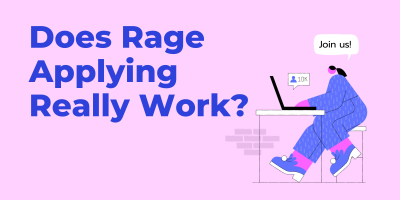
Does Rage Applying Really Work?
Is rage applying just another short-lived TikTok trend or a promising employee strategy for landing a better job?

In a corporate setting where every edge counts in creating leverage over competitors, recruiting strategy plays a crucial role in the success of a company.
To better understand recruiting trends and patterns, below is a list of recruiting statistics to help companies, hiring managers, and job seekers.
According to nearly 5,000 professionals, people were looking for a new job in 2018 because they were bored with their current position. (Kornferry*, 2018)
One-third of respondents said they’d want a new job because they were looking for a new challenge. Only 19% said their top priority of a new job is a higher salary – lower than the number of people who say they are looking because they lost or expect to lose their current employment. 2017 was the fourth year in a row the nation added at least 2 million more jobs. (Kornferry, 2018)
72% of working Americans polled would or may consider leaving a company for one that they believe is more inclusive. Roughly one-quarter of all responders had already done so. (Deloitte**, 2018)
A poll of 1,300 full-time employees throughout the U.S. discovered that an inclusive culture is critical for acquiring and keeping talent. (Deloitte, 2018)
80% of respondents believe that inclusivity is an essential aspect of hiring. (Deloitte, 2018)
Younger generations place a more significant value on an inclusive culture, with 53% of millennials indicating that if they could find the same job, they would leave an organization for an inclusive one. (Deloitte, 2018)
30% of millennials polled have already left a job searching for a more inclusive atmosphere at another company. (Deloitte, 2018)
33% of respondents left previous organizations for more inclusive ones because they didn’t feel comfortable being themselves at their last workplace, followed by not feeling comfortable speaking up and expressing opinions, not experiencing inclusive day-to-day interactions, and not being in an environment that provided a sense of purpose or impact (28% each). (Deloitte, 2018)
Diversity of demographic groupings was identified by 12% of U.S. respondents because they left a prior organization for a more inclusive one. (Deloitte, 2018)
According to nearly half of all respondents (47%), one of the most significant characteristics of an inclusive workplace is “an environment that allows me to be myself.” (Deloitte, 2018)
Almost a third of respondents (32%) feel that senior leadership has by far the most effect on workplace inclusion, while nearly the same number believe that everyone has a role to play (34%). Meaning, to achieve change, action, and direction from the top must be accompanied by commitment at all levels. (Deloitte, 2018)
71% of those polled indicated they would choose an organization with leadership that regularly displays inclusive attitudes over one that offers a variety of initiatives. (Deloitte, 2018)

The labor market, according to 86% of recruiters and 62% of employers, is candidate-driven. (SHRM, 2016)
Passive job seekers account for 73% of all candidates. (HR Cloud, 2019)
Over 14% of candidates stated that the most critical marketing material influencing their decision to apply was the company’s values. (Recruiting Daily, 2015)
According to Glassdoor, 89% of job seekers consider their mobile devices essential for job searching, and 45% use them at least once per day. (Glassdoor, 2021)
Оnly 29% of Australia’s largest companies, 30% of Hong Kong’s largest companies, and 32% of the largest universities in the United States have fully mobile-optimized career sites. Southeast Asia had even lower figures (10%). (Pageuppeople, 2018)
Мobile devices account for 16% of all applications submitted. (Pageuppeople, 2018)
51% of the companies plan to hire temporary employees, and 44% are looking to hire full-time employees. (PR Newswire, 2018)

Recruiting plays a key role in the success of a company. The tools recruiters use can aid or detract from that work. Learn more about the best recruitment software, applicant tracking system, recruiting CRM, video interviewing tool, or candidate sourcing tool.
*We’re using an archived version of the page as the source.
**We’re using an archived version of the page as the source.
***We’re using an archived version of the page as the source.
Browse our curated list of vendors to find the best solution for your needs.
Subscribe to our newsletter for the latest trends, expert tips, and workplace insights!

Is rage applying just another short-lived TikTok trend or a promising employee strategy for landing a better job?

As top talent is becoming more scarce, is hiring from within becoming a critical business objective for growth?

As the search for quality candidates in today’s highly competitive market is relentless, optimizing the onboarding process and improving the employee experience should not be overlooked.

Avoid the financial drain of a bad hire by implementing effective recruitment strategies that will contribute to your team’s success.
Used by most of the top employee benefits consultants in the US, Shortlister is where you can find, research and select HR and benefits vendors for your clients.
Shortlister helps you reach your ideal prospects. Claim your free account to control your message and receive employer, consultant and health plan leads.